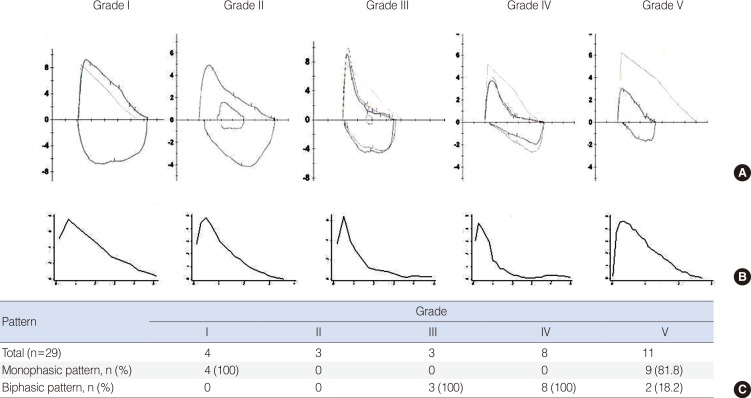Clin Exp Otorhinolaryngol.
2015 Jun;8(2):161-166. 10.3342/ceo.2015.8.2.161.
Changes in the Flow-Volume Curve According to the Degree of Stenosis in Patients With Unilateral Main Bronchial Stenosis
- Affiliations
-
- 1Department of Pulmonary and Critical Care Medicine, Hallym University Kangdong Sacred Heart Hospital, Seoul, Korea. hjk3425@skku.edu
- 2Korea Institute for Industrial Economics and Trade, Seoul, Korea.
- 3Department of Radiology, Samsung Medical Center, Sungkyunkwan University School of Medicine, Seoul, Korea.
- 4Division of Pulmonary and Critical Care Medicine, Department of Medicine, Samsung Medical Center, Sungkyunkwan University School of Medicine, Seoul, Korea. hjk3425@skku.edu
- KMID: 2360788
- DOI: http://doi.org/10.3342/ceo.2015.8.2.161
Abstract
OBJECTIVES
The shape of the flow-volume (F-V) curve is known to change to showing a prominent plateau as stenosis progresses in patients with tracheal stenosis. However, no study has evaluated changes in the F-V curve according to the degree of bronchial stenosis in patients with unilateral main bronchial stenosis.
METHODS
We performed an analysis of F-V curves in 29 patients with unilateral bronchial stenosis with the aid of a graphic digitizer between January 2005 and December 2011.
RESULTS
The primary diseases causing unilateral main bronchial stenosis were endobronchial tuberculosis (86%), followed by benign bronchial tumor (10%), and carcinoid (3%). All unilateral main bronchial stenoses were classified into one of five grades (I, < or =25%; II, 26%-50%; III, 51%-75%; IV, 76%-90%; V, >90% to near-complete obstruction without ipsilateral lung collapse). A monophasic F-V curve was observed in patients with grade I stenosis and biphasic curves were observed for grade II-IV stenosis. Both monophasic (81%) and biphasic shapes (18%) were observed in grade V stenosis. After standardization of the biphasic shape of the F-V curve, the breakpoints of the biphasic curve moved in the direction of high volume (x-axis) and low flow (y-axis) according to the progression of stenosis.
CONCLUSION
In unilateral bronchial stenosis, a biphasic F-V curve appeared when bronchial stenosis was >25% and disappeared when obstruction was near complete. In addition, the breakpoint moved in the direction of high volume and low flow with the progression of stenosis.
MeSH Terms
Figure
Reference
-
1. Murray JF, Mason RJ. Murray and Nadel's textbook of respiratory medicine. 5th ed. Philadelphia: Saunders Elsevier;2010.2. Pellegrino R, Viegi G, Brusasco V, Crapo RO, Burgos F, Casaburi R, et al. Interpretative strategies for lung function tests. Eur Respir J. 2005; 11. 26(5):948–968. PMID: 16264058.3. Husain A, Habib SS. Pattern identification of obstructive and restrictive ventilatory impairment through flow volume curves. Pak J Physiol. 2008; 5. 4(1):30–34.4. Miller RD, Hyatt RE. Obstructing lesions of the larynx and trachea: clinical and physiologic characteristics. Mayo Clin Proc. 1969; 3. 44(3):145–161. PMID: 5776050.5. Miller RD, Hyatt RE. Evaluation of obstructing lesions of the trachea and larynx by flow-volume loops. Am Rev Respir Dis. 1973; 9. 108(3):475–481. PMID: 4745245.6. Guntupalli KK, Bandi V, Sirgi C, Pope C, Rios A, Eschenbacher W. Usefulness of flow volume loops in emergency center and ICU settings. Chest. 1997; 2. 111(2):481–488. PMID: 9042000.
Article7. Gascoigne AD, Corris PA, Dark JH, Gibson GJ. The biphasic spirogram: a clue to unilateral narrowing of a mainstem bronchus. Thorax. 1990; 8. 45(8):637–638. PMID: 2099756.
Article8. Mazzei JA, Barro A, Mazzei ME, Portas T, Esteva H. Biphasic flow volume curve due to obstruction of main bronchus by bronchogenic cyst. Respir Med CME. 2011; 4(3):116–118.
Article9. Choi SJ, Jo MS, Lee HP, Kim JI, Yum HK. A case of biphasic flow-volume loop in left mainstem bronchial stenosis. Tuberc Respir Dis. 1998; 4. 45(2):416–420.
Article10. Roos CM, Braat MC. End-inspiratory flow reduction in the forced flow-volume curve as a sign of unilateral bronchial disease. Neth J Med. 1985; 28(10):378–382. PMID: 4080042.11. Breen PH, Serina ER, Barker SJ. Exhaled flow monitoring can detect bronchial flap-valve obstruction in a mechanical lung model. Anesth Analg. 1995; 8. 81(2):292–296. PMID: 7618717.
Article12. Anzueto A, Levine SM, Tillis WP, Calhoon JH, Bryan CL. Use of the flow-volume loop in the diagnosis of bronchial stenosis after single lung transplantation. Chest. 1994; 3. 105(3):934–936. PMID: 7510602.
Article13. Villaran Y, Sekela ME, Burki NK. Maximal expiratory flow patterns after single-lung transplantation in patients with and without chronic airways obstruction. Chest. 2001; 1. 119(1):163–168. PMID: 11157599.
Article14. Falzon D, Jaramillo E, Schünemann HJ, Arentz M, Bauer M, Bayona J, et al. WHO guidelines for the programmatic management of drug-resistant tuberculosis: 2011 update. Eur Respir J. 2011; 9. 38(3):516–528. PMID: 21828024.
Article15. Beauchemin C, Dixit NM, Perelson AS. Characterizing T cell movement within lymph nodes in the absence of antigen. J Immunol. 2007; 5. 178(9):5505–5512. PMID: 17442932.
Article16. Freitag L, Ernst A, Unger M, Kovitz K, Marquette CH. A proposed classification system of central airway stenosis. Eur Respir J. 2007; 7. 30(1):7–12. PMID: 17392320.
Article17. Gelb AF, Tashkin DP, Epstein JD, Szeftel A, Fairshter R. Physiologic characteristics of malignant unilateral main-stem bronchial obstruction: diagnosis and Nd-YAG laser treatment. Am Rev Respir Dis. 1988; 12. 138(6):1382–1385. PMID: 2462389.
Article18. Revelly JP, Feihl F, Liebling T, Perret C. Time constant histograms from the forced expired volume signal: a clinical evaluation. Eur Respir J. 1989; 6. 2(6):536–542. PMID: 2744137.19. Pimmel RL, Miller TK 3rd, Fouke JM, Eyles JG. Time-constant histograms from the forced expired volume signal. J Appl Physiol Respir Environ Exerc Physiol. 1981; 12. 51(6):1581–1593. PMID: 7319887.
Article20. Karkhanis VS, Joshi JM. Spirometry in chronic obstructive lung disease (COPD). J Assoc Physicians India. 2012; 2. 60(Suppl):22–26. PMID: 23155809.21. Low SY, Hsu A, Eng P. Interventional bronchoscopy for tuberculous tracheobronchial stenosis. Eur Respir J. 2004; 9. 24(3):345–347. PMID: 15358688.
Article
- Full Text Links
- Actions
-
Cited
- CITED
-
- Close
- Share
- Similar articles
-
- A Case of Biphasic Flow-volume Loop in Left Mainstem Bronchial Stenosis
- Biphasic pattern of flow-volume curve (Unilateral main bronchus stenosis)
- Balloon dilatation of bronchial stenosis in adult
- A Case of Bronchial Varices in a Patient with Severe Mitral Stenosis
- A Case of Bronchial Stenosis due to Endotrcheal Suction



